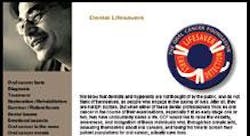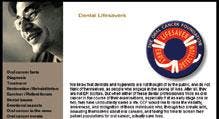A lifeguard's vigilanceOral cancer screenings, without a doubt, save lives.
by Cathleen Terhune Alty, RDH
Hygienists are lifeguards at heart. Our form of lifesaving is something we can do without a bathing suit (thank goodness) or getting wet — well, at least not soaking wet. The life preserver we can throw out to rescue our patients is taking the time to examine every patient's oral mucosa, head, and neck carefully for anything out of the ordinary. When it comes to detecting changes in oral mucosa, we're the first line of defense. Oral cancer screenings are too often rushed or skipped completely in the crush of the daily schedule. But it can have life changing results for hygienists as well as patients.
Cathy Collins, RDH, of Apple Valley, Minn., performed a routine oral cancer screening on a patient. She was credited as discovering a lesion that was early stage one squamous cell carcinoma of the maxilla. She was nominated in February 2002 by the patient as an Oral Cancer Foundation Lifesaver. Her patient is now considered an oral cancer survivor and she is considered a hero.
The Oral Cancer Foundation offers this award to dental professionals because they know that in the course of dentists and hygienists "just doing our job" a life can be saved, especially if the lesion is caught in its early stages.
"A visit to the dentist is not just about cosmetics, hygiene, a crown, or filling," the foundation says on its recognition Web page. "When oral cancer screenings are part of a complete dental examination, it is also about saving a life." We need to be doing more screenings in our day and we need to start immediately.
Brian R. Hill, the founder and executive director of the Oral Cancer Foundation, is a stage-three oral cancer survivor himself.
"When I was diagnosed with cancer," he said, "I could not find any answers to my questions. There was little of substance on the Web, and what was there was — except for the National Cancer Institute — was full of misinformation. So after I was in remission I set up the foundation to create an informational site that would bridge this gap." Hill later created a survivor/patient forum on the site and now the site is also an activist/advocacy organization.
Unlike other cancers, oral cancer has not seen a measurable decrease in incidence or increase in survival rate. The statistics are sobering. Approximately every hour, 24/7, a person dies from oral or pharyngeal cancer. There are more than 30,000 new cases of oral and pharyngeal cancer diagnosed each year in the United States, which represents about 4 percent of all cancers. The five-year survival rate is about 50 percent for patients diagnosed with oral cancer. Seventy-five percent of all head and neck cancers begin in the oral cavity. Ninety percent of oral cancers are squamous cell carcinoma. This cancer is typically seen in individuals over 40 years old with a history of tobacco use, but can be found across the population. The majority of cases are patients who will never feel any pain from a lesion and may not even notice anything unusual in their mouth.
As you know, cancers are healthy cells that have undergone transformation. Because of various combinations of chemical, biological, physical, or lifestyle risk factors, thousands of cells can mutate or change in the course of a single day.
These mutating cells have all the instructions for how to properly behave, but sometimes they get out of whack. If a mutated cell is unable to repair its damaged DNA, there's real trouble brewing. Because once a rebellious cell begins it's out-of-control proliferation, this neoplastic cell can pass on these mutations to its progeny. Then this whole brood of mutants begins multiplying and the tumor spreads mayhem throughout the body.
In oral cancer, the cumulative damage from chemical, lifestyle, biological and physical risk factors are the instruments of these mutations. Tobacco in all its forms is number one on the list of chemical and lifestyle risk factors that lead to oral cancer. A full 75 percent of those diagnosed with oral or pharyngeal are current or former tobacco users. Smokers consume an estimated 600 billion cigarettes in the United States every year. Alcohol use appears to have a synergistic effect as smoking and drinking alcohol create a much higher risk for oral and pharyngeal cancers. Lifestyle risk factors also include poor diet, especially one low in fruits and vegetables, sexual practices, and genetic or ethnic susceptibility.
Physical factors include exposure to UV radiation, a main cause of lip lesions, and cumulative X-ray exposure.
Biological risk factors include viruses, such as human papilloma virus (HPV), a common sexually transmitted virus. It is estimated 40 million Americans are infected with one or more of the 80 strains of HPV. HPV16 and 18 have been implicated in some cancers, including some oral cancers. Surgeries and medications, particularly immunosuppressive therapies used in organ and bone marrow transplants, create a greater risk of developing oral cancer. Almost half of leukoplakia lesions have been found to have dysplastic or invasive cells upon biopsy. Other biologic risk factors, such as lichen planus, an inflammatory disease of the oral mucosa, are assumed to play a role in the development of oral cancers but have not been definitively pinpointed as a cancer causative.
"The core of this gets back to early diagnosis," says Hill. "A recent article just published shows that early detection through opportunistic screenings yields patients in the lower stages which are much more curable and survivable. This is what I have been saying all along. Now we need to get the dental community to do more screenings on their patient populations, something which isn't happening often enough. Oral cancers, the majority of the time, are caught in later stages, where the survival rates are very low."
In its early stages, oral cancers can be painless and virtually invisible. Early lesions may appear as subtle and often innocent-looking changes in color, texture or elasticity. The area may appear white or red, ulcerated or indurated, wart-like or granular, eroded, or fissured. The most common locations are the lips, lateral borders of the tongue, or the floor of the mouth. The vestibular folds between the cheek and mandible are common sites for tissue changes in those who use smokeless tobacco. The hard palate and tonsular pillars are unusual but not unknown sites for cancer.
Hill's cancer site was a dime-sized red spot on the right tonsular pillar, which quickly metastasized to both sides of his neck.
The subtleness of these lesions often leads to a wait-and-see approach that can have devastating effects. Experts agree that it is often difficult to decide which tissues are abnormal and are worthy of testing. If a lesion has been present for 14 days or longer, the protocol is to have it tested. The most accurate diagnosis of a tissue abnormality is biopsy.
Biopsy is the most common form of cell sampling. An incision or punch biopsy is usually recommended for lesions that are suspicious in nature. For those hard to distinguish areas, especially leukoplakias and other innocuous appearing changes, the oral brush biopsy has made it much easier for all practitioners to test for dysplastic cells instead of watching and waiting. It's easy to use, inexpensive and takes less than a week for the report to come back from the lab. The stiff, round brush is place on the lesion, twisted into the lesion to collect a full thickness of mucosal epithelial cells, and they are smeared on a slide. A packet of fixative is squeezed over the sample and it is forwarded to the laboratory. Although brush biopsy is not able to give the specific cell architecture of a sample, it can tell if malignancy exists or not. If a malignancy does exist, treatment can begin quickly while it is still in its earliest and most treatable stage.
A patient being treated for oral cancer will have plenty of challenges ahead. Radiation, dry mouth, loss of taste, fungal or bacterial infections, tooth demineralization, dehydration and/or malnutrition, swallowing difficulties, and other medical/dental complications can reduce a patient's quality of life significantly. Starting preventive measures prior to cancer treatment can prevent decay and soft tissue problems. Those who undergo surgery to have cancer removed have unique problems to contend with when they have missing oral structures.
Compared to other cancer screening tests, oral cancer screenings are relatively easy to perform, are non-invasive, and comfortable for the patient. Hill said the Oral Cancer Foundation is currently lobbying dental licensing boards in all 50 states to require oral cancer screenings. If you do them now, pat yourself on the back and spread the word. If you haven't been doing them lately, decide today to become a lifesaver. Don't miss your chance to really do your job thoroughly and reduce the death rate of this disease.
Cathleen Terhune Alty, RDH, is a frequent contributor. She is based in Clarkston, Mich.
Web page for Oral Cancer Foundation
Lifesavers in dentistryThe following dental professionals were acknowledged for being "lifesavers" by the Oral Cancer Foundation.
• Kevin Pass, DDS, and Harold Krueger II, DDS, of Overland Park, Kan., were nominated by Lisa Owen, an oral cancer survivor, stage one, squamous cell carcinoma of the tongue
• Dr James S. Perry, DDS, of Shakopee,Minn was nominated by Mona Carpenter, an oral cancer survivor, stage one, squamous cell carcinoma of the mouth
• Charles Hurst, DDS, Kirsten Hurst, RDH, of Mission Viejo, Calif., and Sharo Fatehi, DDS, of Laguna Hills, Calif., were nominated by Steve Deering, an oral cancer survivor, stage one, squamous carcinoma of the tongue
• W. Stephan Eakle, DDS, of San Francisco was nominated by Sigrid Schafmann, oral cancer survivor, stage one, mucoepidermoid carcinoma
• Michael E. Learman, DDS, of Bay City, Mich.,was nominated by Lisa Bourdon-Krause, oral cancer survivor, stage two squamous cell carcinoma of the tongue
• Brett Veerman, DDS, of Madison, Wis., was nominated by Larry Sharp, oral cancer survivor, stage one, squamous carcinoma of the tongue
• Randy Julian, DDS, of Apple Valley, Minn., was nominated by Dave Stefonowicz, oral cancer survivor, stage one, squamous cell carcinoma of the maxilla
• Cathy Collins, RDH, of Apple Valley, Minn., was nominated by Dave Stefonowicz, oral cancer survivor, stage one squamous cell carcinoma of the maxilla
• Mark Miller, DDS, of Tustin, Calif., was nominated by Joe Fancher, oral cancer survivor, stage two squamous cell carcinoma of the maxilla
• www.oralcancerfoundation.org
• www.emedicine.com — search for "oral cancer"
• www.oralscan.com/dentists — information on the oral brush (Oral CDxR) biopsy technique
• www.ada.org — November 2001 JADA, "Oral Cancer and It's Detection," by James J. Sciubba, DMD, PhD
• http://cis.nih.nci.gov — Cancer Information Service, National Cancer Institute (NCI) SEER Program documentation, statistics on oral cancer

